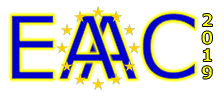Speakers
Description
The recent installation of a double plasma mirror in the experimental area of the Lund High-Power Laser facility now allows the study of laser-plasma interactions with stable, pre-pulse and pedestal-free laser pulses. Such a regime of high contrast (10e-8 at 1 ps before the pulse peak) ensures that targets with nm-scale thicknesses can be irradiated without forming a pre-plasma at their surface, resulting in more reproducible and controlled experimental conditions, and thus opening the possibility to investigate finer processes involved in laser-driven proton acceleration.
Here we present our recent experimental study on the effect of the spectral properties of the laser pulse on the cutoff energy of TNSA-driven proton beams. We manipulated the laser spectral phase to deliver chirped and skewed pulses to sub-µm carbon foils, observing a 30% enhancement of the proton energies with positively-chirped pulses. Effects of third order dispersion appear to play a minor role with respect to the chirp.
Our results suggest that positively-chirped pulses bring about a more efficient absorption mechanism that may be related to piling up of hot electrons at the front surface of the target on a sub-ps time scale. Details of the acceleration process are currently being explored with Particle-In-Cell simulations.

